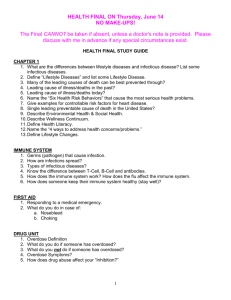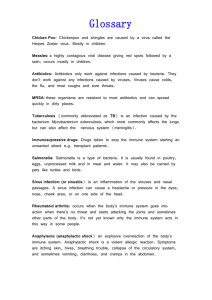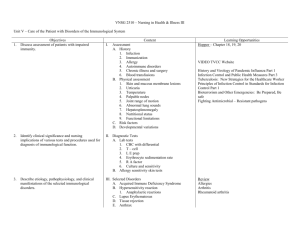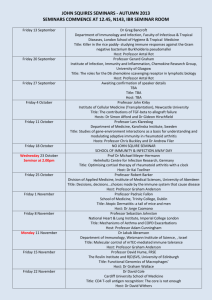Mathematical Immunology of Infectious Diseases
advertisement
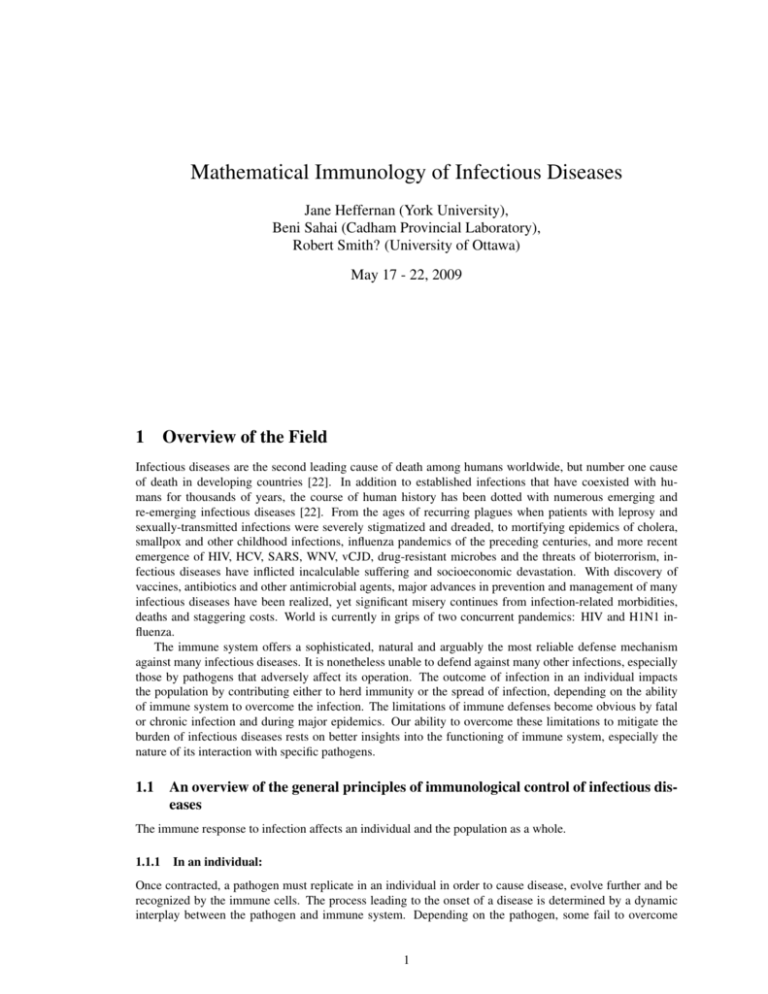
Mathematical Immunology of Infectious Diseases Jane Heffernan (York University), Beni Sahai (Cadham Provincial Laboratory), Robert Smith? (University of Ottawa) May 17 - 22, 2009 1 Overview of the Field Infectious diseases are the second leading cause of death among humans worldwide, but number one cause of death in developing countries [22]. In addition to established infections that have coexisted with humans for thousands of years, the course of human history has been dotted with numerous emerging and re-emerging infectious diseases [22]. From the ages of recurring plagues when patients with leprosy and sexually-transmitted infections were severely stigmatized and dreaded, to mortifying epidemics of cholera, smallpox and other childhood infections, influenza pandemics of the preceding centuries, and more recent emergence of HIV, HCV, SARS, WNV, vCJD, drug-resistant microbes and the threats of bioterrorism, infectious diseases have inflicted incalculable suffering and socioeconomic devastation. With discovery of vaccines, antibiotics and other antimicrobial agents, major advances in prevention and management of many infectious diseases have been realized, yet significant misery continues from infection-related morbidities, deaths and staggering costs. World is currently in grips of two concurrent pandemics: HIV and H1N1 influenza. The immune system offers a sophisticated, natural and arguably the most reliable defense mechanism against many infectious diseases. It is nonetheless unable to defend against many other infections, especially those by pathogens that adversely affect its operation. The outcome of infection in an individual impacts the population by contributing either to herd immunity or the spread of infection, depending on the ability of immune system to overcome the infection. The limitations of immune defenses become obvious by fatal or chronic infection and during major epidemics. Our ability to overcome these limitations to mitigate the burden of infectious diseases rests on better insights into the functioning of immune system, especially the nature of its interaction with specific pathogens. 1.1 An overview of the general principles of immunological control of infectious diseases The immune response to infection affects an individual and the population as a whole. 1.1.1 In an individual: Once contracted, a pathogen must replicate in an individual in order to cause disease, evolve further and be recognized by the immune cells. The process leading to the onset of a disease is determined by a dynamic interplay between the pathogen and immune system. Depending on the pathogen, some fail to overcome 1 2 Infectious diseases Respiratory infections HIV/AIDS Diarrhoeal diseases Tuberculosis Vaccine-preventable childhood diseases Malaria STDs (other than HIV) Meningitis Hepatitis B and C Tropical parasitic disease Dengue Other infectious diseases Annual deaths (million) 3.96 2.77 1.80 1.56 1.12 1.27 0.18 0.17 0.16 0.13 0.02 1.76 Figure 1: Infectious diseases worldwide. About 25% of annual deaths worldwide are the direct result of infectious diseases [27]. This does not include millions who die as a consequence of past infections such as streptococcal rheumatic heart disease, cervical neoplasia after HPV infection, liver failure or hepatocellular carcinoma following chronic hepatitis B or C infection [18] 3 the initial barriers presented by the nonspecific components of the innate immunity and do not replicate adequately to cause disease, whereas others readily overcome these barriers and replicate in sufficient numbers to produce disease in infected individuals. This interaction between the pathogen and the components of innate immunity triggers generation of an adaptive immune response that usually consists of pathogen-specific oligoclonal cytotoxic T cells (CTLs) and antibody molecules. The combined action of CTLs and antibodies is usually required to suppress pathogen replication and, in turn, reverse disease symptoms. CTLs suppress pathogen replication by destroying the infected cells that support its replication, whereas antibodies neutralize the pathogen by binding to an epitope on its surface that is required for pathogen to enter into a host cell or subject pathogen to destruction through opsonization by phagocytic cells or lyses by the complement system. The individuals so retain an immunological memory of the pathogen in form of long-lived pathogen-specific memory CTLs and B cells capable of producing antibodies against the pathogen in case of re-infection. The examples of infections typically controlled by the adaptive immune response include mumps, chickenpox, measles, rubella and influenza. Such infections are often vaccine-preventable and there are successful vaccination programs to prevent them. However, when the replication cycle of a pathogen interrupts any step of the formation of CTLs or antibodies, by direct interaction or by assuming latency, the adaptive immune response does not develop or develops inadequately. Such responses fail to halt pathogen replication or reverse disease symptoms. Their examples include HIV, HCV, HSV-1, tuberculosis and malaria infections. Empirical vaccines directed against these pathogens have not been successful. These infections are therefore not vaccine-preventable. 1.1.2 In a population: The spread of a disease from a single infected individual to others in a population of wholly susceptible individuals is described by its reproductive number, R0 , which is a combined function of the pathogen dynamics in the infected individual and the efficiency of pathogen transmission (see [11] for a review of R0 ). The latter is affected by the stability of the pathogen and the mode and route of its transmission. The value of R0 can be greatly affected by (i) the contact structure which is different, for example, for school, home, healthcare facility, factory or office; (ii) the herd immunity which is affected by prior exposure to the same pathogen or vaccination; (iii) the control measures such as chemoprophylaxis, isolation or quarantine; and (iv) the immunodemography of the population concerned. The values of R0 > 1 signify the spread of infection, whereas those < 1 are indicative of the control of spread and even the potential for eradication of the disease. There are at least three distinct areas where R0 is regulated immunologically; that is when immune system impacts the dynamics of infection in a population: first, by regulating the pathogen dynamics in vivo; second, by affecting herd immunity, and third, by an altered immunodemography through change in the immune status due to age, disease or therapy. There may yet be additional avenues of its impact such as emergence of drug resistance. 1.2 Importance of mathematical modeling in immunology and infectious diseases Immunology is a science of dynamic interactions amongst a highly specialized array of lymphoid and myeloid leukocytes (white blood cells) and soluble cytokines released by them (Fig. 2). The latter trigger or affect the migration and interactions between various leukocytes and their responses directed to protect the integrity of the organism concerned. Major advances in our knowledge of the organization and function of the immune system are symbolized by 30 Nobel Prizes in Physiology or Medicine to individuals for works in immunology and related fields during the last century. Yet, significant gaps in knowledge continue to exist. While experimental research has made outstanding contributions by identification and physical characterization of the key components of immune system and their mutual interactions, an understanding of their dynamical behavior as these relate to suppression or persistence of an infection remains limited. The underlying immunologic criteria vis--vis pathogen properties necessary to attain a disease-free state during an infectious process have not been understood. These limitations have led to major setbacks in progress towards development of vaccine (for example, against HIV, HCV or malaria) and novel immunotherapeutic and other antimicrobial agents, prevention and treatment of autoimmunity and related disorders, and prevention and management of drug resistance. Mathematical modeling holds great promise in providing new, counterintuitive insights into the dynamical processes 4 Figure 2: The principal leukocytes that drive the adaptive immune response to infection are CD4+ T, CD8+ T, B, and plasma cells of the lymphoid origin as well as monocytes and dendritic cells of the myeloid origin. Other leukocytes (not shown here) that influence the course or magnitude of adaptive immune response are natural killer (NK) and regulatory T cells of lymphoid origin, and polymorphic neutrophils, eosinophils and mast cells of myeloid origin as well as platelets. Cells release chemokines (RANTES, MIP1 ) and cytokines that are either chemotactic (MCP1-3, IL-8) or inflammatory (IL-2, IFN- , TNF- , IL-1, IL-6, IL-12) or antiinflammatory (IL-10, TGF- ). 5 intrinsic to mechanism and control of infectious diseases. Pioneered by Daniel Bernoulli in 1760 [5], mathematical modeling has an illustrious history in predicting and rationalizing the spread or control of infectious diseases in a population. Current literature is rich with epidemiological models, which have greatly added to our understanding of outbreaks, epidemics and pandemics of diverse pathogens. Notably, the principles enunciated by Hamer in 1906 [10] and later extended by Ronald Ross [21] in 1911 and Kermack and McKendrick in 1927 [13], form true foundations of mathematical epidemiology today. In those days, when influenza virus was not yet discovered and the knowledge of immunological protection against an infectious disease was minimal, the limited criteria that differentiated one disease from the other were mostly captured in their values of R0 and estimates of incubation period. These models were limited in their abilities to inform about the disease process. In 1980s Robert May and Roy Anderson consolidated concepts in mathematical epidemiology [1] and provided new insights into spread of HIV infection. As insights into immune responses to infection and the nature of pathogen diversity grew, some epidemiological models began incorporating specific features of the pathogen and even immune responses to infection in attempts to enhance their predictability. The initial efforts were met with limited success owing to a sparse understanding of immunological mechanisms and complexities of interaction between a pathogen and the immune system. Not until late 1980s that several investigators (most notably Alan Perelson, Robert May, Robert Nowak, Roy Anderson, and Simon Levin) developed simple yet insightful in-host models to describe the dynamical behavior of pathogens and specific immune cells and antibodies, in particular during HIV and influenza infection (see [16, 17, 19, 20] for reviews). These contributions actually laid the foundations of mathematical immunology. In 1995, a counterintuitive finding, realized through use of relatively simple mathematical models, that the replication rate of HIV is great in magnitude and thus, the current antiretroviral therapies would be inadequate in eliminating HIV from infected patients [12, 23], made resounding impacts both clinically and in understanding of the mechanism of HIV pathogenesis. This finding also highlighted the important roles mathematical models may play in uncovering the intricacies of an infectious process and in evaluating the adequacy of therapeutic strategies. This pioneering work triggered a surge of new, more complex immunological models addressing different aspects of HIV infection. The dawn of the 21st century witnessed remarkable leaps in immunological modeling emanating from collaborative research between Rustom Antia (a mathematical modeler) and Rafi Ahmed (a prominent immunologist) at Emory University in Atlanta that aimed to decipher the mechanisms of development of antiviral CTLs and CTL memory in mouse models of LCMV infection [2, 3, 4, 9]. These models were preceded or followed by several notable contributions in immunology through mathematical modeling ranging from basic T cell biology and diversity of T cell repertoire to control of viral, bacterial or parasitic infection by investigators such as Rob DeBoer at Utrecht University , Denise Kirschner at University of Michigan at Ann Arbor, Dominik Wodarz at University of California at Irvine (see [6, 7, 8, 14, 15, 24, 25, 26] for examples) and others such as those mentioned in the preceding paragraph. These investigators modeled selected immunological processes implicit in control of infectious diseases in vivo. However, several key mechanisms and their fundamental principles that drive these processes and, in turn, impact the infectious process have not been fully understood. In many cases, important new insights can be attained through in-depth explorations with mathematical and computational modeling. Consequently, a comprehensive model that provides a theoretical framework for assessing or monitoring immunological control of an infectious process has not been developed, but crucial for making needed advances. 2 Open questions in immunology and immunological control of infectious diseases Several unanswered questions pertaining to the immunological control of infection have hampered the development of a comprehensive immunological model that could monitor dynamic interactions between a pathogen and the immune system during an infection. To appreciate them, a brief account of the immune response to infection may be warranted. The monocytes, dendritic cells, natural killer (NK) cells, and neutrophils are non-specific components of the innate immunity (Fig.2) which, during the course of infection, either facilitate the formation or directly serve as antigen-presenting cells (APC). APCs engulf the pathogen and the dying infected cells through phagocytosis and in response (i) release inflammatory and chemotac- 6 tic cytokines and chemokines, and (ii) process short antigenic peptides from the pathogen and display them on their surface together with MHC class I or II molecules. While chemotactic cytokines recruit additional leukocytes to the site of infection, the pathogen peptide-bearing APCs trigger onset of cellular immune response that encompasses selection, activation and clonal expansion of pathogen-specific CD4+ T (helper) and CD8+ T (cytotoxic) cells from a diverse T cell repertoire, and their direct and cytokine-mediated effects on mitigating the infectious process. Aided by the helper T cell response, the pathogen and its proteins trigger activation and pathogen-specific antibody secretion from B cells bearing receptors that specifically bind to them. Some of these B cells, in turn, differentiate into antibody-secreting, long-lived plasma cells. The antibody and other soluble factor response are commonly referred to as humoral immune response. The following is a select list of outstanding questions that so far remain unaddressed: 1. The formation and dynamics of diminution of the diversity of T and B cell repertoires as a function of age, vaccination, and acute or chronic infection; 2. The relationship between the rate of pathogen replication and suppression of infection by innate immune response and the dynamics of generation of APCs; 3. Conditions causing pathologic inflammation from chemotaxis and its possible control by immunological memory; 4. The mechanism of control of T cell proliferation (the finite number of cell divisions) during antigendriven clonal expansion of T cells and factors affecting this process; 5. The mechanism of formation of effector and central memory T cells and relationship between them; 6. The mechanisms of homeostatic proliferation and long-term sustenance of nave and memory T cells, and the waning of T cell memory; 7. The relationship between the incubation period of an infectious disease and the ability of the immune response to suppress primary or secondary infection, to prevent death; 8. The impact of memory CTLs in controlling the spread viral infection in vivo and in the population; 9. The impact of pathogen mutation vis--vis the ability of CTLs to suppress infection; 10. The relationship between immunological control of infection and pathogen evolution including the development of drug resistance; and 11. A model providing theoretical framework for novel vaccine designs. In view of the aforesaid and in attempts to link immunological characteristics of a disease to its epidemiological models, this workshop was structured under the following interrelated themes: 1. Organization and function of the immune system (Insights in immune organization and principles inherent in a typical immune response) 2. Mechanism of a disease process (Enhancing understanding of the mechanism of a specific disease or its key principles) 3. Assessment of novel drug or immune therapies (Evaluating a therapeutic agent based on its impact on pathogen dynamics in vivo) 4. Pathogen evolution: changing virulence, drug resistance or extinction (Elucidating genetic and immunological forces intrinsic to pathogen evolution) 5. Vaccine design and evaluation (Utilizing in-host models to aid the design and preclinical evaluation of vaccines) 7 6. Specific in-host processes affecting the spread or control of disease in population (Factoring biological characteristics of a disease that affect its spread or control) 7. Vaccination or antimicrobial strategies for population-wide control of disease (Specialized epidemic models to evaluate vaccination and antimicrobial strategies) 8. Novel mathematical techniques and barriers to in host immune modeling (Descriptions of new mathematical techniques, parameter estimation strategies, and existing barriers to modeling immune response and pathogen dynamics in vivo) 3 Recent developments The workshop consisted of the 8 themes listed above. Each session consisted of a plenary talk, contributed talks and a discussion period. The workshop allowed younger researchers and postdocs to present their results and experienced researchers to present an overview of their work. The presentations were of very high quality and stimulated interesting discussions. Speakers and abstracts of plenary talks are listed below in alphabetical order: Rob deBoer Utrecht University Estimating the killing efficacy of cytotoxic T cells In order to defend our bodies against viruses, Cytotoxic T Lymphocytes (CTL) continuously migrate through nearly all tissues searching for infected cells. When a CTL finds a suitable target, they form a cytotoxic synapse, and the target cell is killed after some time. It is unclear how many target cells a CTL kills per day, how many CTL are required to clear a viral infection, and what proteins should be targeted for optimal protection. Mathematical modeling has demonstrated that the cytotoxic control of rapidly expanding pathogens requires a large initial population of CTLs, and we have shown that this can explain the failure of current HIV vaccines. We have analyzed experimental data on estimating the killing rate of CTL, and argue that these experiments readily deliver the (fast) death rate of target cells, but that estimating the killing rate per CTL requires more information on the functional form of the killing term. We propose to analyze in vivo movies in which one can observe how cells find each other in vivo, and how long they are attached before the target cell is killed. The efficacy of CTL is not only determined by their numbers and the rate at which they kill. Immune response to particular viral epitopes seem much more protective than those to others. One factor is the time course at which the epitope is expressed, and we will review experimental, bioinformatic and modeling results that in HIV infection targeting early epitopes may be most protective and can explain otherwise surprising observations. 8 Peter Bretscher University of Saskatchewan Macroimmunology and immunological intervention The activation of CD4 T cells is required to initiate most immune responses, and the cytokine profile of the activated CD4 T cells determines the qualitative nature of the ensuing immune response. Two questions will be addressed: what determines whether antigen activates or inactivates CD4 T cells, and how is their Th1/Th2 phenotype determined? The prevalent views are that pathogen-associated molecular patterns (PAMPs) are required to activate CD4 T cells, and that their nature determines the Th1/Th2 phenotype of the response. Arguments against these views will be presented. A valid understanding of how the Th1/Th2 phenotype of a response is determined must account for why various variables of immunization affect this Th1/Th2 phenotype. There are several quantitative variables of immunization affecting this phenotype. The ability of the ”Threshold Hypothesis”, that attempts to delineate how the Th1/Th2 phenotype of a response is determined, to account for these quantitative variables of immunization will be presented, and contrasted with non-quantitative theories based upon the activity of PAMPs. The quantitative framework developed has been successfully tested experimentally and allows one to understand how broad parameters of the immune response determine its Th1/Th2 phenotype. Detailed information is not necessary to understand how this phenotype is determined and to control its nature. Our ”macro-immunological” framework has allowed us to develop strategies to prevent or cure those infectious diseases where the Th1/Th2 phenotype of an immune response against the pathogen is critical to whether the pathogen is contained or causes chronic/progressive disease. Evidence as to the effectiveness of strategies based upon the ”Threshold Hypothesis” will be presented. The quantitative considerations, underlying the framework developed, should provide a rich context for mathematical modeling to gain greater insight into the underlying processes. Matt Keeling University of Warwick Presented by: Jane Heffernan (York University) Immuno-epidemiolgy: bringing together within-host and between-host dynamics for measles One of the major challenges in the study of infectious diseases is bringing together immunological models with epidemiological ones. Here we develop and parameterise a within-host model for the dynamics of measles (an acute childhood infection), whose resultant dynamics can be used to drive an epidemiological model. Under the assumption of life-long immunity the population-level dynamics of these two models are identical; however, there is some evidence to suggest that immunity to measles wanes slowly. Such waning immunity can only be mechanistically captured by a within-host model. Prior to vaccination, waning of immunity is epidemiological irrelevant as repeated re-exposure to the virus leads to multiple boosting events. We show however that with high levels of vaccination immunity can wane to such an extent that large-scale epidemics can ensue. We discuss the implications of this observation and the insights that immuno-epidemiology can bring to infection control. 9 Alan Perelson Las Alamos National Laboratory Stochastic models of early HIV-1 infection Not every encounter with HIV/SIV leads to infection. In the case of needle stick injury about 1 out of every 200 sticks leads to infection. Within discordant couples, one of whom is HIV positive and one whom is not, HIV infection occurs in about 1 out of every 1000 sex acts. Further, when HIV/SIV infection results, there can be a long eclipse phase during which time HIV/SIV remains at undetectable levels. To explain the low frequency of successful infections and the length of the eclipse phase we are developing stochastic models of early infection. I will present some simple models and preliminary analytic and simulation results. Beni Sahai Cadham Provincial Laboratory Immunological control of influenza infection and basis for creation of a universal vaccine In addition to annual epidemics, influenza A viruses of unpredictable genetic constitution and origin are responsible for major pandemics that have dotted human history with dire outcomes. Infection with a virulent influenza A strain in the absence of any preexisting immunity can be fatal. The immunity needed to prevent death can persist independent of that needed to avoid infection. Learning their separation is crucial for limiting influenzarelated deaths, devising vaccination strategies, and pandemic planning. While delineating the key features of immunological control of influenza infection in vivo, this presentation aims to provide new insights into dynamics of spread of infection in the respiratory tract and the importance of preexisting memory CTLs in limiting illness and preventing death. These insights constitute the basis for creation of a universal vaccine capable of eliciting lasting immunity against influenza A viruses irrespective of their inter-strain differences. 4 Identification of key areas for future work The workshop consisted of the 8 themes listed above. Each session consisted of a plenary talk, contributed talks and a discussion period. In the discussion period the section chairs briefly summarized the key points to each talk and lead with some questions to open the discussion. Some key areas for future work were identified in both areas of immunology and mathematics. 4.1 Areas for future work in immunology • Clonal expansion of T cells leading to antiviral CTL response and T cell memory • Perturbations of T cell diversity during chronic infection • Defining conditions for CTL escape • Rationalizing appearance of HIV mutants with multiple mutated CTL epitopes • CTL failure during early HIV infection • Un-helpful CTL responses during some viral infections (HIV, HBV, HTLV-1) • Immunological control of influenza infection and basis for a universal vaccine • Shaping of evolution and dynamics of variant surface antigens of malaria parasite by anti-malaria immune response • Impact of preexisting memory CTLs on viral dynamics in vivo and the spread of infection in population 10 • Antiviral suppression of viral dynamics in vivo and the spread of infection in population: HIV and pandemic influenza • Principles and hurdles to eradication of an infectious disease through vaccination • Relating in-host and between-host dynamics 4.2 Areas for future work in mathematics • Optimizing control strategies • Stochastic vs Deterministic Models • Tradeoffs between complex biological systems and simple models • Model structure at the in-host and between-host interface 5 Outcome of the Meeting The workshop fostered new contacts and collaborations. Participants learned about the immune system and how it is modelled, identified areas for future work and discussed possible avenues to reach these goals. A possible proceedings of the workshop or special issue on the key ares of future work was discussed and future collaborative meetings and workshop were envisioned. Two groups of individuals emphasized the need for future workshops in the areas of mathematical immunology. One group emphasized the need to further understand the dynamics of the immune system at the cellular and mechanistic level. They stated that they had used some free time during the workshop to write a proposal for a future meeting. Another group decided to propose a future workshop on immuno-epidemiology. They stated that comprehensive models will improve the accuracy of epidemiological predictions, they are key to further understanding the evolution of resistance and virulence and had the capacity to determine optimal control strategies including vaccine and drug therapies. A goal of our workshop was to bring together participants in varying stages of their research careers. A quick survey of the junior participants shows that overall, their workshop experience was very positive and has lead to research projects stemming from the key areas of research discussed above. Some have also already published their studies in internationally recognized journals. Sessions in mathematical immunology have been associated with every major mathematical biology conference in recent years, sponsored by SMB, ECMTB, CMS, CAIMS, JSMB, SIAM. However, it is rare to find such senior researchers in the area at these conferences together. It is also rare to have focussed discussions identifying areas for future research. Summer schools and workshops in mathematical epidemiology and mathematical biology have recently started to include courses in modelling immunology. A future goal of our workshop participants is to have a summer school focussing solely on the immune system, its interaction with pathogens and how this can be modelled. Our workshop has given a conducive environment for discussion and collaboration in this growing field. We thank BIRS for their hospitality and this great opportunity. References [1] R.M. Anderson and R.M. May, 1991. Infectious diseases of humans: dynamics and control. Oxford: Oxford University Press. [2] R. Antia, C. T. Bergstrom, S. S. Pilyugin, S. M. Kaech, and R. Ahmed, 2003. Models of CD8+ responses: 1. what is the antigen-independent proliferation program. J. Theor. Biol. 221, 585-598. [3] R. Antia, V. V. Ganusov, and R. Ahmed, 2005. The role of models in understanding CD8(+) T-cell memory. Nat Rev Immunol 5, 101-11. 11 [4] R. Antia, S.S. Pilyugin, and R. Ahmed, 1998. Models of immune memory: on the role of cross-reactive stimulation, competition, and homeostasis in maintaining immune memory. Proc. Natl. Acad. Sci. USA 95, 14926-14931. [5] D. Bernoulli, 1760. Essai dune, nonvelle analyse de la mortalite causee par la petite verole, et des advantages de linoculation pour la preventir. Mem. Acad. R. Sci. 195. [6] M.J. Blaser and D. Kirschner, 2007. The equilibria that allow bacterial persistence in human hosts . Nature 449, 483-489. [7] R.J. De Boer, V.V. Ganusov, D. Milutinovic, P.D. Hodgkin and A.S Perelson, 2006. Estimating lymphocyte division and death rates from CFSE data. Bull. Math. Biol. 68, 1011-1031. [8] R.J. De Boer, D. Homann and A.S. Perelson, 2003. Different dynamics of CD4(+) and CD8(+) T cell responses during and after acute lymphocytic choriomeningitis virus infection. J. Immunol. 171, 39283935. [9] R. J. De Boer, M. Oprea, R. Antia, K. Murali-Krishna, R. Ahmed, and A. S. Perelson, 2001. Recruitment times, proliferation, and apoptosis rates during the CD8(+) T-cell response to lymphocytic choriomeningitis virus. J. Virol. 75, 10663-10669. [10] W.H. Hamer, 1906. Epidemic disease in England - the evidence of variability and of persistency of type. Lancet (i), 733-739. [11] J.M. Heffernan, R.J. Smith and L.M. Wahl, 2005. Perspectives on the basic reproductive ratio. J. R. Soc. Interface, 2, 281-293. [12] D.D. Ho, A.U. Neumann, A.S. Perelson, W. Chen, J.M. Leonard and M. Markowitz, 1995. Rapid turnover of plasma virions and CD4 lymphocytes in HIV-1 infection. Nature 373, 123-126. [13] W.O. Kermack and A.G. McKendrick, 1927 A contribution to the mathematical theory of epidemics. Proc. R. Soc. Lond. A 115, 700-721. [14] D. Kirschner, 1996. Using mathematics to understand HIV immune dynamics. AMS Notices, 191-202. [15] D. Kirschner and G.F. Webb, 1998. A mathematical model of combined drug therapy of HIV infection. J Theor Med 1, 25-34. [16] S.A. Levin, J. Dushoff and J.B. Plotkin, 2003. Evolution and persistence of influenza A and other diseases. Math Biosci 188, 17-28. [17] R.M. May and R.M. Anderson, 1987. Transmission dynamics of HIV infection. Nature London 326, 137-142. [18] D.M. Morens, G.K. Folkers and A.S. Fauci, 2004. The challenge of emerging and re-emerging infectious diseases. Nature 430, 242-249. [19] M.A. Nowak and R.M. May, 2000. Virus Dynamics. Oxford University Press, Oxford. [20] A.S. Perelson, 2002. Modelling viral and immune system dynamics. Nat. Rev: Immunol. 2, 28-36. [21] R. Ross, 1911. The prevention of malaria. London: John Murray. [22] J.W. Sanders, G.S. Fuhrer, M.D. Johnson and M.S. Riddle, 2008. The epidemiological transition: the current status of infectious diseases in the developed world versus the developing world. Science Progress, 91, 1-38. [23] L.M. Wei, S.K. Ghosh, M.E. Taylor, V.A. Hohnson, E.A. Emini, P. Deutsch, J.D. Lifson, S. Bonhoeffer, M.A. Nowak, B.H. Hahn, M.S. Saag and G.M. Shaw, 1995. Viral dynamics in HIV-1 infection. Nature 373, 117-122. 12 [24] D. Wodarz D, 2008. Immunity and protection by live attenuated HIV/SIV vaccines. Virology 378, 299305. [25] D. Wodarz and D.N. Levy, 2007. Human immunodeficiency virus evolution towards reduced replicative fitness in vivo and the development of AIDS. Proc. Biol. Sci. 274, 2481-90. [26] D. Wodarz, S. Sierro and P. Klenerman, 2007. Dynamics of killer T cell inflation in viral infections. J R Soc Interface 4, 533-543. [27] WHO, 2004. The World Health Report 2004 (World Health Organization, Genve, 2004).



